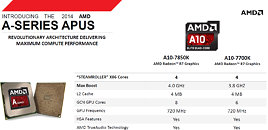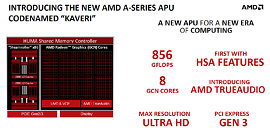- Joined
- Oct 9, 2007
- Messages
- 47,300 (7.52/day)
- Location
- Hyderabad, India
| System Name | RBMK-1000 |
|---|---|
| Processor | AMD Ryzen 7 5700G |
| Motherboard | ASUS ROG Strix B450-E Gaming |
| Cooling | DeepCool Gammax L240 V2 |
| Memory | 2x 8GB G.Skill Sniper X |
| Video Card(s) | Palit GeForce RTX 2080 SUPER GameRock |
| Storage | Western Digital Black NVMe 512GB |
| Display(s) | BenQ 1440p 60 Hz 27-inch |
| Case | Corsair Carbide 100R |
| Audio Device(s) | ASUS SupremeFX S1220A |
| Power Supply | Cooler Master MWE Gold 650W |
| Mouse | ASUS ROG Strix Impact |
| Keyboard | Gamdias Hermes E2 |
| Software | Windows 11 Pro |
Specifications of two of AMD's top next-generation APUs, the A10-7850K and A10-7700K, were leaked to the web, revealing an incremental or evolutionary upgrade over the 6000 "Richland" series. To begin with, the two are based on the 28 nm "Kaveri" silicon. Straightaway we find that AMD hasn't been able to catch up with Intel's 22 nm leap for close to two years. All that it manages is to bring the rated TDP of the overclockable "K" chips down to 95W, from the traditional 100W. "Kaveri" puts three of AMD's recent innovations in CPU and GPU on one chip - "Steamroller" CPU micro-architecture, "Graphics CoreNext" GPU architecture, and hUMA (heterogeneous Uniform Memory Access), a technology that allows the CPU and GPU to access the same portion of memory simultaneously.
"Steamroller" features the same component hierarchy and basic design as its predecessors "Piledriver" and "Bulldozer," in which clumps of two cores that feature dedicated and shared number-crunching resources, called modules, make up the basic units of a processor. "Kaveri" features two such modules, and hence features four CPU cores. "Kaveri" misses out on an L3 cache cushioning transfers between the modules, and other uncore components on the APU yet again, and each module features a 2-megabyte L2 cache at its last level, totaling the L2 cache amount to 4 MB on "Kaveri." The integrated memory controller features a 128-bit (dual-channel) DDR3 memory interface, with support for standards as high as DDR3-2133 MHz on some models. The PCI-Express root complex complies with the newer PCIe gen 3.0 standard, as do we imagine the A-Link (chipset bus). AMD introduced huge changes with the GPU component.



47 percent of the die-area of "Kaveri" is occupied by its GPU, which is designed to restore AMD's competitiveness with Intel's Iris Pro 5000 series. The GPU is based on AMD's "Graphics CoreNext" (GCN) micro-architecture. Physically, there are 512 stream processors present on the chip, arranged in 8 GCN compute units (CUs). Other specifications include 32 TMUs, and 8 ROPs. The GPU supports technologies AMD introduced with its Radeon R7-260X graphics card, including TrueAudio. The GPU supports DirectX 11.2, OpenGL 4.3, and Mantle. It's capable of handling 4K Ultra HD video.
Among the two parts detailed today are the A10-7850K flagship, and the A10-7700K. The A10-7850K features CPU clock speeds of 3.70 GHz, with 4.00 GHz TurboCore frequency, the GPU with all its 512 stream processors unlocked, and GPU clock speeds of 720 MHz. The A10-7700K, on the other hand, offers CPU clock speeds of 3.50 GHz, with 3.80 GHz TurboCore frequencies, and cut-down GPU with just 6 compute units, 384 stream processors, and 24 TMUs clocked at 720 MHz. Both chips are expected to be priced under $150, when they go on sale this January. AMD "Kaveri" APUs are compatible with the newer socket FM2+ motherboards characterized by black-colored CPU sockets, and thicker pins. FM2+ motherboards themselves offer backwards-compatibility with older "Richland" and "Trinity" APUs.
View at TechPowerUp Main Site
"Steamroller" features the same component hierarchy and basic design as its predecessors "Piledriver" and "Bulldozer," in which clumps of two cores that feature dedicated and shared number-crunching resources, called modules, make up the basic units of a processor. "Kaveri" features two such modules, and hence features four CPU cores. "Kaveri" misses out on an L3 cache cushioning transfers between the modules, and other uncore components on the APU yet again, and each module features a 2-megabyte L2 cache at its last level, totaling the L2 cache amount to 4 MB on "Kaveri." The integrated memory controller features a 128-bit (dual-channel) DDR3 memory interface, with support for standards as high as DDR3-2133 MHz on some models. The PCI-Express root complex complies with the newer PCIe gen 3.0 standard, as do we imagine the A-Link (chipset bus). AMD introduced huge changes with the GPU component.



47 percent of the die-area of "Kaveri" is occupied by its GPU, which is designed to restore AMD's competitiveness with Intel's Iris Pro 5000 series. The GPU is based on AMD's "Graphics CoreNext" (GCN) micro-architecture. Physically, there are 512 stream processors present on the chip, arranged in 8 GCN compute units (CUs). Other specifications include 32 TMUs, and 8 ROPs. The GPU supports technologies AMD introduced with its Radeon R7-260X graphics card, including TrueAudio. The GPU supports DirectX 11.2, OpenGL 4.3, and Mantle. It's capable of handling 4K Ultra HD video.
Among the two parts detailed today are the A10-7850K flagship, and the A10-7700K. The A10-7850K features CPU clock speeds of 3.70 GHz, with 4.00 GHz TurboCore frequency, the GPU with all its 512 stream processors unlocked, and GPU clock speeds of 720 MHz. The A10-7700K, on the other hand, offers CPU clock speeds of 3.50 GHz, with 3.80 GHz TurboCore frequencies, and cut-down GPU with just 6 compute units, 384 stream processors, and 24 TMUs clocked at 720 MHz. Both chips are expected to be priced under $150, when they go on sale this January. AMD "Kaveri" APUs are compatible with the newer socket FM2+ motherboards characterized by black-colored CPU sockets, and thicker pins. FM2+ motherboards themselves offer backwards-compatibility with older "Richland" and "Trinity" APUs.
View at TechPowerUp Main Site







 .
.